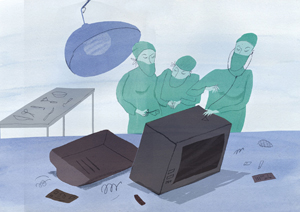Poking holes in TV medical dramas—and loving it
By MITZI BAKER
Television’s most famous surgical interns, Christina Yang and Izzie Stevens, sneak down to the morgue one night to perform an un-authorized autopsy they hope proves their theory of a patient’s death. When it shows they’re right, the attending physician, their boss, lets this transgression slide.
Salvatore Rubinno |
|
 |
|
At this point, a collective groan issues from all viewers of this episode of Grey’s Anatomy who have even the slightest amount of medical training. No one in the field, not even an intern, would get away with what these doctors do. But, hey, it’s TV!
Talk to medical professionals hooked on medical TV — they’re easy enough to find — and you’ll find they have a love-hate relationship with the shows. They pretty much love to hate everything the shows get wrong.
“I enjoy these shows because they are so unrealistic that I don’t feel like I am at work,” says Suzanne Miller, MD, a recent Stanford emergency medicine resident who is starting a practice in Washington, D.C.
Kathy Reagan, manager of the emergency medicine residency program, laughs over the characters all arriving at the same time in the morning, not terribly early at that; always managing to take breaks and eat lunch together; and on top of that, finding parking spaces in front of the hospital. “Only in a fairy tale!” she says. She is a self-confessed Grey’s Anatomy fanatic.
In an hour of TV, fictional doctors get to see more high-adrenaline cases than many real doctors see in an entire career. It helps that TV docs flit from one specialty to another, which allows them to function as a one-person team. “On House, the residents run the CT scanner and they draw blood and they give the meds and perform surgery, which is totally bogus,” notes fourth-year medical student Graham Walker. “So if people just watched House, they would think their actual doctors are slacking off because they aren’t doing all of that.”
Related News
“On one Grey’s Anatomy episode, a patient comes in with chest pain, and two seconds later, he is rushed to open-heart surgery. That is hardly realistic,” says Prasanna Ananth, in her fifth year of medical school. But it doesn’t stop her from watching.
Joshua Spanogle, MD, who graduated in June, recalls, “A writing mentor here at Stanford said to me: ‘Now Josh, I must ask this: Is there really that much sex in the hospital?’” This floored Spanogle. “I was thinking that everyone knows that Grey’s Anatomy is not an accurate portrayal of life in the hospital.” Either that or he’s been hanging out in all the wrong linen closets.
But underlying the wacky story lines, these shows do offer a few grains of truth about the world of medicine, say the professionals. Residency is really hard work, medicine is an art not a science and doctors wrangle daily with ethical issues. Still, the mistakes seldom entail illegal acts, such as severing a patient’s cardiac assist device so he can get a heart transplant. And the ethical issues rarely arise from sleeping with your attending physician.
The funny thing is, many doctors and students take the shows seriously. Their senses of humor flatline when confronted with inaccuracies they deem dangerous. Indeed, keep the details real if possible, implores Spanogle, who has published two medical thrillers. “I pump up some elements of course,” he admits. “But I try to keep the consequences and the environment as real as I can.”
Portrayals of CPR bear the brunt of criticisms. A 1996 article in the New England Journal of Medicine documented the discrepancy between the survival rates from CPR on three medical TV shows and those seen in the real world. On the shows, more than two-thirds survive, compared with just around 5 percent in reality. In addition, TV characters’ methods are far gentler, and they tend to use poor technique — with an incorrect ratio of breaths to compressions. The issue is still reverberating.
Real-life E.R. doc Miller says she once asked a patient’s brother how he learned to do CPR. “He said he saw it on ER,” she says. “He said that’s how they did it on the show — and he saved his brother’s life, so that’s pretty darn good.” ER, which began its 15-year run in 1992, is widely known as the most accurate and educational of the fictional medical shows. “If these shows are going to do CPR, for sure you want them to do it as realistically as possible so that people can learn that lifesaving technique,” she says.
Says medical student Walker: “I feel like there are simple things that wouldn’t have any detrimental effect to the entertainment quality of the show — that would barely even change dialogue — that could provide subconscious education to the lay public.” He devoted a page of his blog Over My Med Body to an episode of Grey’s Anatomy that portrayed CPR inaccurately.
A medical advisor of that show is Karen Pike, MD, a Bay Area emergency physician who did her residency at Stanford. “I’ve tried to address the CPR issue,” says Pike, whose standing joke is: “Do the patients have to cardiac arrest again?” She notes that one episode of the show was devoted to showing the intern George O’Malley being astonished to discover that most people who have cardiac arrest die. So she does try to inject a dose of reality into the show — but her advice is sometimes ignored. “A patient coming back to life pulls at people’s heartstrings,” she says. “I have to remember that it’s still Hollywood.”
Comments? Contact Stanford Medicine at

